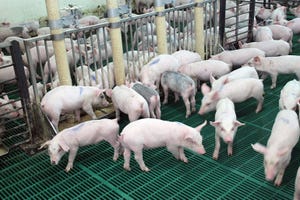Next project co-funded by U.S. and Canadian feed and commodity associations to see if feed mill equipment can be decontaminated after pathogens are found.
April 25, 2022

From its inception in 2015, the Pork Checkoff-funded Swine Health Information Center has been a leader in enabling research priorities to identify the risk and mitigation of feed ingredients as a route for introduction and transmission of swine diseases. Since 2016, SHIC has invested Checkoff-sourced resources in 20-plus projects to conduct research geared at protecting the U.S. swine herd from the risk of future disease threats through the route of feed and feed ingredients.
"Feed is a unique risk for swine diseases due to the global sourcing of ingredients and the direct access to pigs in high-biosecurity commercial operations," says Megan Niederwerder, associate director of SHIC. "Learning from the introduction of porcine epidemic diarrhea virus in 2013, SHIC research investments have helped broaden our knowledge of feed risks for additional swine diseases of highest concern."
Several important research objectives on understanding feed as a risk for swine diseases have been targeted and investigated through SHIC-funded projects and projects co-funded with other funding agencies, USDA, as well as pork production and allied industry companies, including: 1. importation, 2. stability, 3. transmission, 4. mitigation, 5. diagnostics, 6. field investigations and 7. risk assessments. Examples highlighting some of the successful work conducted are described below:
Importation: To define imported soy-products used in feed as a risk for introduction of swine diseases, SHIC-funded research has quantified the volume of certain soy-based products imported from countries with foreign animal diseases. Findings identified India, Argentina and Ukraine as the countries positive for FAD from which the greatest quantities of soy-based ingredients were imported.
SHIC also convened the major manufacturers of vitamins imported from other areas of the world. Manufacturing parameters, prevention of contamination post-production and relative risk from these products were presented and agreed upon.
Stability: To determine if commonly imported feeds or ingredients support virus stability, SHIC-funded research has characterized the stability of 14 viruses across 12 feed ingredients or products of animal origin when exposed to simulated transoceanic shipment conditions. Early projects using laboratory quantities of feed ingredients led to interstate transport of bulk feed totes to translate results to real-world conditions. Findings identified soybean meal as stabilizing the greatest number of viruses and identified Senecavirus A, African swine fever virus and pseudorabies virus as being stable in the greatest number of feed ingredients.
Bringing together the soy commodity organization and processing companies to discuss soy products' contribution to feed risk garnered support from that industry. Research priorities were identified and addressed by the soybean checkoff association.
Transmission: To characterize the risk of virus transmission through the natural consumption of contaminated feed, research never done before investigated the infectious dose and volume of contaminated feed necessary to result in infection of pigs with foot-and-mouth disease virus and SVA. Findings confirmed that FMDV and SVA are transmissible through natural consumption of contaminated feed.
Chemical Mitigation: To determine efficacy of chemical mitigation tools for reducing the risk of feed for swine pathogens, SHIC helped evaluate several different chemical feed additives for their ability to inactivate viruses in feed, such as ASFV, FMDV, SVA, PEDV and porcine reproductive and respiratory syndrome virus. Among the findings, medium chain fatty acid and formaldehyde-based feed additives were confirmed effective at reducing the infectivity of ASFV in feed ingredients.
Physical Mitigation: To determine efficacy of physical mitigation tools for reducing the risk of feed for swine pathogens, SHIC-funded research investigating storage time necessary at various temperatures to inactivate PRRSV and SVA contaminated soybean meal. Findings confirmed that 30 days of storage at 75°F was effective at reducing the risk of virus infection through consumption of contaminated feed.
Next on the docket is a project co-funded by U.S. and Canadian feed and commodity associations to see if feed mill equipment and its environment can be decontaminated after pathogens are found. A combination of physical and chemical protocols are being investigated for the ability to clean mill equipment not designed to take apart and wash.
Diagnostics: To optimize detection of virus contamination within swine feed, SHIC-funded research compared feed sampling techniques in bulk ingredients and nucleic acid extraction techniques to identify protocols which enable the highest detection efficiencies. Findings defined an effective bulk sampling protocol and identified a commercially available nucleic acid extraction kit with the highest sensitivity for PRRSV and SVA detection in feed.
Field Investigations: To investigate the role of contaminated feed from feed mills in field outbreaks of U.S. endemic swine diseases, timely research performed diagnostic surveillance for SVA and porcine deltacoronavirus in feed and environmental samples from outbreaks associated with feed mills. Findings identified feed delivery vehicles as potential risks for disease spread due to detectable PDCoV in truck samples.
Risk Assessment: To calculate the risk of imported feed as a route for ASFV introduction, a quantitative risk assessment modelling ASFV introduction into the United States through contaminated corn or soybean meal imports has been completed. The risk assessment included probabilities of ASFV contamination, inactivation during processing and transport, recontamination and inactivation during customs clearance.
"By generating this cumulative body of knowledge over the last six years, SHIC-funded research has provided valuable data on feed risk to the swine industry as well as outlined a roadmap for investigative steps to target emerging risks for disease introduction," says Niederwerder. "Feed biosecurity and feed safety, from ingredient sourcing to feed delivery vehicles, are critical components to overall biosecurity plans for the protection of U.S. swine."
Source: Swine Health Information Center, which is solely responsible for the information provided, and wholly owns the information. Informa Business Media and all its subsidiaries are not responsible for any of the content contained in this information asset.
You May Also Like



